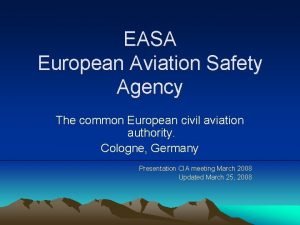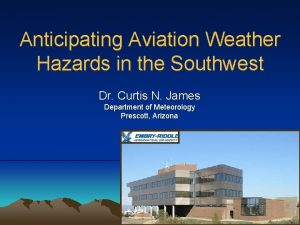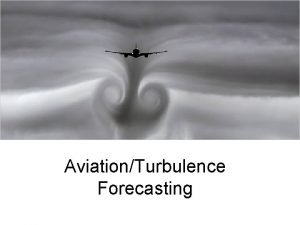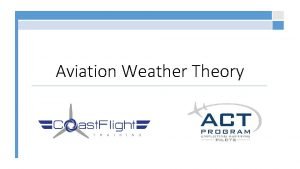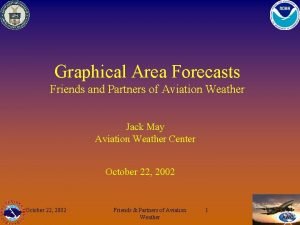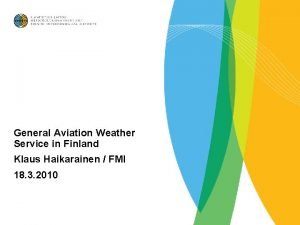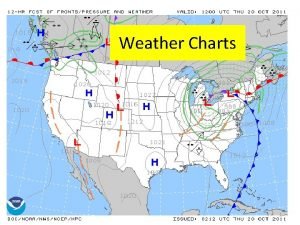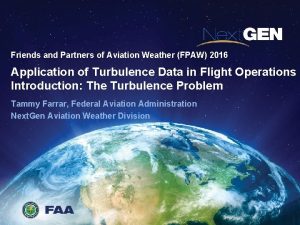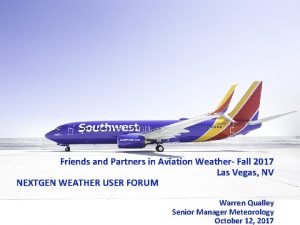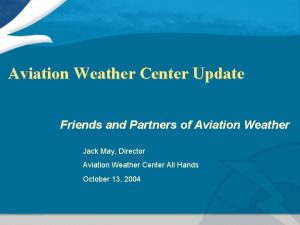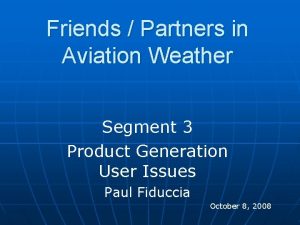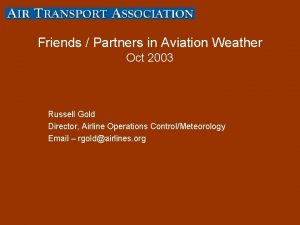Friends and Partners in Aviation Weather FPAW Weather








- Slides: 8

Friends and Partners in Aviation Weather FPAW) Weather Technology in the Cockpit (WTIC) Planning and Status Update Eldridge Frazier July 22, 2014 1

Weather Technology in the Cockpit (WTIC) Program Description • Research projects to develop, verify, and validate requirements for incorporation into Minimum Weather Service (Min. Wx. Svc) standards • • • FAR Part 121, OPERATING REQUIREMENTS: DOMESTIC, FLAG, AND SUPPLEMENTAL OPERATIONS (i. e. commercial operations) FAR Part 135, OPERATING REQUIREMENTS: COMMUTER AND ON DEMAND OPERATIONS AND RULES GOVERNING PERSONS ON BOARD SUCH AIRCRAFT (i. e. commuter, on demand, and air taxi operations) FAR Part 91, GENERAL OPERATING AND FLIGHT RULES (includes General Aviation operations) • The Min. Wx. Svc is defined as: • • • Minimum cockpit meteorological (MET) information Minimum performance standards (e. g. accuracy) of the MET information Minimum information rendering standards FY 13 Enacted FY 14 Enacted FY 15 President’s Budget Submission $4. 8 M $4. 04 M

WTIC – Eddy Dissipation Rate (EDR) Update • Completing operational demonstration on cockpit display of turbulence information • Benefits assessment post demo – Benefits to aircraft and NAS to be assessed • Developing technical transfer package 3

Adverse Weather Alerting • Researching potential benefits of providing adverse weather alerting in GA and Part 121 Turbulence alerting using NTDA separate alerting project Candidates: microbursts, hail, icing, non-convective turbulence, low IFR, high crosswinds, etc 4

WTIC – Standards Development • WTIC research and deliverables to support standards, guidance, and training material development • GA training modules planned to be posted on FAA training site • RTCA standards alignment among contributing special committees (SC-186, SC-206, SC-214, SC-227) 5

RTCA Special Committee 206 • Established Feb. 11, 2005 at the request of the FAA to address the future ATM concept of: Establishing the aircraft as a primary participant in collaborative decision making (CDM). Transitioning to a global Aeronautical Information Management (AIM) environment. Using Broadcast, Demand, and Contract data link modes for accessing AIS/MET information. Establishing the data link services as the normal (or primary) means for cockpit receipt & decisions using time-critical information For the first two deliverables listed below, this SC worked in conjunction with EUROCAE WG-76 • Leadership Co-Chairs: Rocky Stone, United Airlines and Allan Hart, Honeywell Designated Federal Official: Eldridge Frazier, FAA - Weather Research Branch Secretary: Tom Evans, NASA RTCA Program Directors: Sophie Bousquet • Sub-groups #4 (DO-252) Tim Rahmes, Boeing & Tammy Farrar, FAA #5 (MOPS) Stephanie Smith, Garmin & Paul Freeman, ITT Exelis #6 (MASPS) Matt de Ris, Panasonic Avionics Corporation & Allan Hart, Honeywell Deliverable Date Completed Status Document # Operational Service and Environment Description (OSED) for Aeronautical Information Services (AIS) and Meteorological (MET) Data Link Services Dec 2007 Released DO-308 Safety and Performance Requirements (SPR) for AIS and MET Data Link Services Oct 2010 Released DO-324 Wake Vortex, Air Traffic Management, and Weather Applications OSED June 2012 Released DO-339 Concept of Use of AIS and MET Data Link Services (supports MASPS) June 2012 Released DO-340 December 2013 Released DO-349 June 2014 Approved December 2014 In works December 2015 In works AIS and MET Services Delivery Architecture Recommendations Revise DO-252 to include performance standards for determining EDR and meteorological sensor reports and status Minimum Operational Performance Standards (MOPS) for Flight Information Services – Broadcast (FIS-B) with Universal Access Transceiver (UAT) Minimum Aviation System Performance Standards (MASPS) for AIS and MET Services

WTIC General Aviation Gap Analyses • Multiple projects performing research to identify safety hazards at least in part attributable to a gap of MET information the cockpit • Sample gaps and shortfalls Inconsistent recognition of changing weather states between commercial presentation As low as 26% recognition of METAR changing from MFR to IMC Weather related incidents/accidents decision based versus skill based Interim research indicating as much as 70% GA aircraft penetrating convective weather had NEXRAD on board GA MET equipment marketing is primarily feature based versus use and application based 7

WTIC - Future • Displays - Integrating information on the flight deck Weather integrated with other information Human factors for hazard alerting Integration of airborne sensor data into 4 -D weather • Sensing and information processing Research on new and enhanced external sensors Automated weather hazard monitoring • Net-centric information sharing 8

